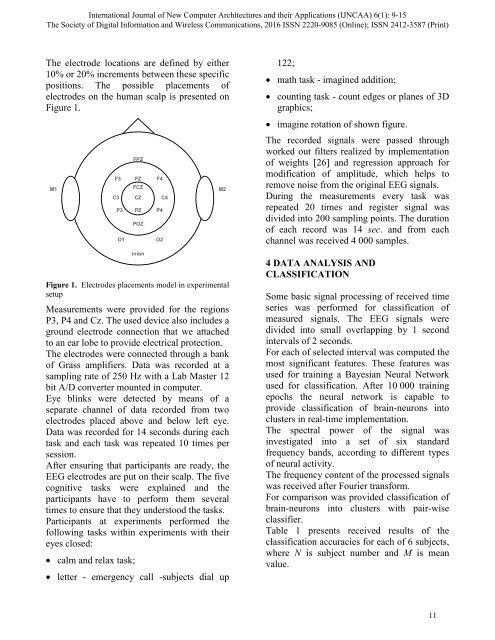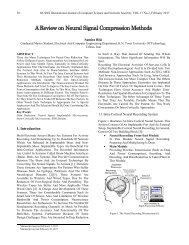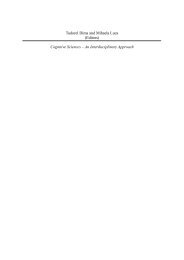New Computer Architectures and their Applications
IJNCAA_Vol6No1
IJNCAA_Vol6No1
Create successful ePaper yourself
Turn your PDF publications into a flip-book with our unique Google optimized e-Paper software.
International Journal of <strong>New</strong> <strong>Computer</strong> <strong>Architectures</strong> <strong>and</strong> <strong>their</strong> <strong>Applications</strong> (IJNCAA) 6(1): 9-15<br />
The Society of Digital Information <strong>and</strong> Wireless Communications, 2016 ISSN 2220-9085 (Online); ISSN 2412-3587 (Print)<br />
The electrode locations are defined by either<br />
10% or 20% increments between these specific<br />
positions. The possible placements of<br />
electrodes on the human scalp is presented on<br />
Figure 1.<br />
M1<br />
F3<br />
C3<br />
P3<br />
O1<br />
FPZ<br />
FZ<br />
FCZ<br />
CZ<br />
PZ<br />
POZ<br />
inion<br />
Figure 1. Electrodes placements model in experimental<br />
setup<br />
Measurements were provided for the regions<br />
P3, P4 <strong>and</strong> Cz. The used device also includes a<br />
ground electrode connection that we attached<br />
to an ear lobe to provide electrical protection.<br />
The electrodes were connected through a bank<br />
of Grass amplifiers. Data was recorded at a<br />
sampling rate of 250 Hz with a Lab Master 12<br />
bit A/D converter mounted in computer.<br />
Eye blinks were detected by means of a<br />
separate channel of data recorded from two<br />
electrodes placed above <strong>and</strong> below left eye.<br />
Data was recorded for 14 seconds during each<br />
task <strong>and</strong> each task was repeated 10 times per<br />
session.<br />
After ensuring that participants are ready, the<br />
EEG electrodes are put on <strong>their</strong> scalp. The five<br />
cognitive tasks were explained <strong>and</strong> the<br />
participants have to perform them several<br />
times to ensure that they understood the tasks.<br />
Participants at experiments performed the<br />
following tasks within experiments with <strong>their</strong><br />
eyes closed:<br />
calm <strong>and</strong> relax task;<br />
letter - emergency call -subjects dial up<br />
F4<br />
P4<br />
O2<br />
C4<br />
M2<br />
122;<br />
math task - imagined addition;<br />
counting task - count edges or planes of 3D<br />
graphics;<br />
imagine rotation of shown figure.<br />
The recorded signals were passed through<br />
worked out filters realized by implementation<br />
of weights [26] <strong>and</strong> regression approach for<br />
modification of amplitude, which helps to<br />
remove noise from the original EEG signals.<br />
During the measurements every task was<br />
repeated 20 times <strong>and</strong> register signal was<br />
divided into 200 sampling points. The duration<br />
of each record was 14 sec. <strong>and</strong> from each<br />
channel was received 4 000 samples.<br />
4 DATA ANALYSIS AND<br />
CLASSIFICATION<br />
Some basic signal processing of received time<br />
series was performed for classification of<br />
measured signals. The EEG signals were<br />
divided into small overlapping by 1 second<br />
intervals of 2 seconds.<br />
For each of selected interval was computed the<br />
most significant features. These features was<br />
used for training a Bayesian Neural Network<br />
used for classification. After 10 000 training<br />
epochs the neural network is capable to<br />
provide classification of brain-neurons into<br />
clusters in real-time implementation.<br />
The spectral power of the signal was<br />
investigated into a set of six st<strong>and</strong>ard<br />
frequency b<strong>and</strong>s, according to different types<br />
of neural activity.<br />
The frequency content of the processed signals<br />
was received after Fourier transform.<br />
For comparison was provided classification of<br />
brain-neurons into clusters with pair-wise<br />
classifier.<br />
Table 1 presents received results of the<br />
classification accuracies for each of 6 subjects,<br />
where N is subject number <strong>and</strong> M is mean<br />
value.<br />
11






